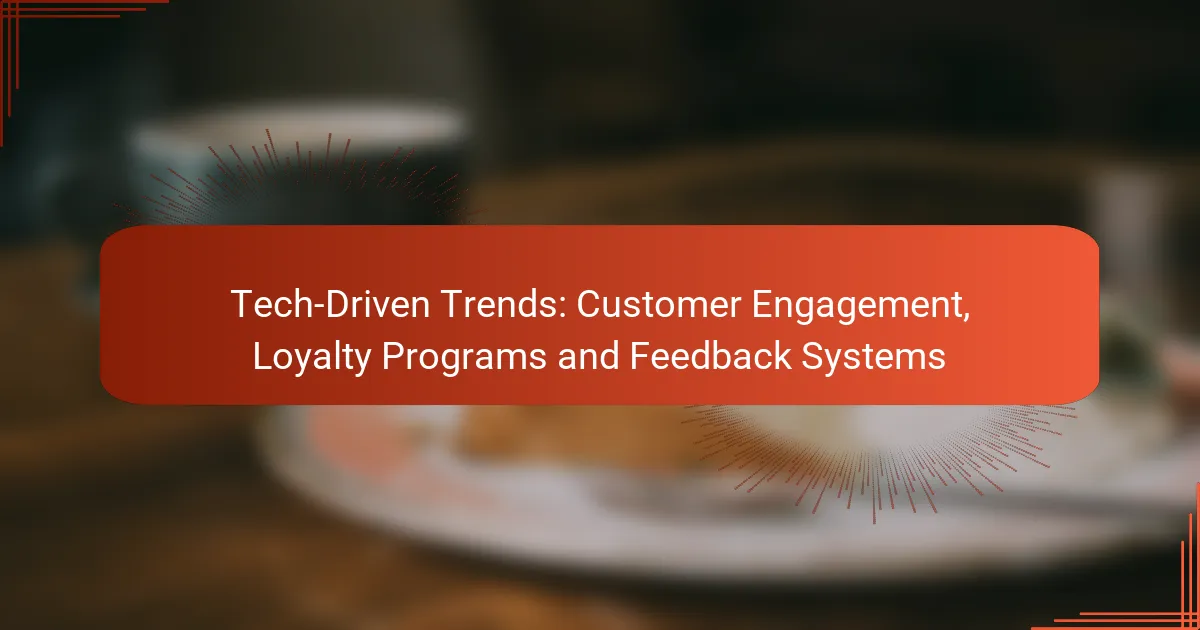In today’s digital landscape, technology plays a crucial role in enhancing customer engagement through personalized experiences and real-time interactions. By implementing effective loyalty programs and feedback systems, businesses can not only retain customers but also foster deeper connections that drive satisfaction and loyalty. These innovations allow companies to adapt to customer preferences, ultimately creating more rewarding shopping experiences.

How can technology enhance customer engagement in e-commerce?
Technology enhances customer engagement in e-commerce by enabling personalized experiences, facilitating real-time interactions, and integrating social platforms. These advancements help businesses connect with customers more effectively, leading to increased loyalty and satisfaction.
Personalized marketing strategies
Personalized marketing strategies leverage customer data to tailor messages and offers based on individual preferences and behaviors. This can include targeted email campaigns, product recommendations, and customized landing pages that resonate with specific customer segments.
To implement personalized marketing, businesses should collect and analyze data from various sources, such as purchase history and browsing behavior. Tools like customer relationship management (CRM) systems can help manage this data effectively.
Common pitfalls include over-segmentation, which can lead to missed opportunities, and failing to respect customer privacy. Always ensure compliance with data protection regulations like GDPR when handling personal information.
Interactive chatbots
Interactive chatbots enhance customer engagement by providing instant responses to inquiries and assisting with common tasks, such as order tracking and product recommendations. They can operate 24/7, ensuring customers receive support whenever they need it.
When implementing chatbots, consider using natural language processing (NLP) to improve the quality of interactions. Regularly update the chatbot’s knowledge base to include new products, services, and frequently asked questions.
However, avoid relying solely on chatbots for customer service. Always provide an option to connect with a human representative for complex issues to maintain customer satisfaction.
Social media integration
Social media integration allows e-commerce businesses to engage customers where they spend a significant amount of time. By linking social media profiles to online stores, brands can promote products, share user-generated content, and encourage social sharing.
To maximize the benefits of social media integration, utilize platforms like Instagram and Facebook for shoppable posts, enabling direct purchases from social feeds. Consider running targeted ads to reach specific demographics and drive traffic to your site.
Be mindful of the varying regulations regarding advertising and data privacy on different platforms. Ensure that your marketing practices align with local laws to avoid potential legal issues.

What are effective loyalty programs for online shoppers?
Effective loyalty programs for online shoppers are designed to enhance customer retention by rewarding repeat purchases and encouraging engagement. They often incorporate various strategies that cater to customer preferences, making shopping more rewarding and personalized.
Points-based rewards systems
Points-based rewards systems allow customers to earn points for every purchase, which can be redeemed for discounts or free products. This straightforward approach appeals to shoppers who appreciate tangible rewards for their loyalty. For instance, a retailer might offer 1 point for every dollar spent, with 100 points equating to a $10 discount.
To maximize effectiveness, businesses should ensure that the points system is easy to understand and that redemption options are attractive. Avoid overly complicated rules that could frustrate customers and deter participation.
Tiered membership benefits
Tiered membership benefits create different levels of rewards based on customer spending or engagement, encouraging shoppers to reach higher tiers for better perks. For example, a brand might offer silver, gold, and platinum levels, with each tier providing increasing discounts, exclusive access to sales, or free shipping.
Implementing tiered systems can motivate customers to spend more to unlock higher rewards. However, it’s crucial to communicate the benefits clearly and ensure that the thresholds for advancement are achievable to maintain customer interest.
Referral incentives
Referral incentives reward customers for bringing in new shoppers, creating a win-win situation for both parties. For instance, a retailer might offer a $10 credit to both the referrer and the new customer upon the new customer’s first purchase. This strategy not only drives new business but also fosters a sense of community among existing customers.
To effectively implement referral programs, make the process simple and the rewards appealing. Avoid complex referral criteria that could discourage participation, and consider promoting the program through email or social media to reach a wider audience.

How do feedback systems improve customer satisfaction?
Feedback systems enhance customer satisfaction by enabling businesses to gather insights directly from their customers, allowing for timely adjustments and improvements. By understanding customer needs and preferences, companies can create better experiences that foster loyalty and engagement.
Real-time feedback collection
Real-time feedback collection allows businesses to capture customer opinions immediately after an interaction, whether it’s a purchase, service call, or website visit. This immediacy helps identify issues quickly, enabling prompt resolutions that can significantly boost satisfaction levels.
Methods for real-time feedback include pop-up surveys on websites, mobile app prompts, and SMS surveys. Companies should aim for a response rate of around 10-20% to ensure they gather meaningful data without overwhelming customers.
Sentiment analysis tools
Sentiment analysis tools process customer feedback to gauge overall feelings towards a brand or product. By analyzing text from reviews, social media, and surveys, these tools can categorize sentiments as positive, negative, or neutral, providing valuable insights into customer perceptions.
Implementing sentiment analysis can help businesses identify trends and areas for improvement. For effective use, companies should regularly review sentiment reports and adjust strategies based on customer emotions, focusing on recurring themes in feedback.
Customer satisfaction surveys
Customer satisfaction surveys are structured questionnaires designed to measure how well a company meets customer expectations. These surveys can be distributed via email, websites, or during service interactions, and typically include questions on various aspects of the customer experience.
To maximize effectiveness, surveys should be concise, ideally taking no more than 5-10 minutes to complete. Including a mix of quantitative (e.g., rating scales) and qualitative (e.g., open-ended) questions can provide a comprehensive view of customer satisfaction and highlight specific areas for improvement.

What criteria should be considered when selecting engagement tools?
When selecting engagement tools, consider integration capabilities, user-friendliness, and cost-effectiveness. These factors ensure that the tools enhance customer interactions and fit seamlessly into your existing systems.
Integration capabilities
Integration capabilities refer to how well the engagement tools can connect with your current software and platforms. Look for tools that offer APIs or built-in integrations with popular CRM systems, email marketing platforms, and social media channels.
For example, a tool that integrates with Salesforce can streamline customer data management, making it easier to track interactions and personalize communications. Prioritize tools that support data synchronization to avoid manual updates and potential errors.
User-friendliness
User-friendliness is crucial for ensuring that both your team and customers can navigate the engagement tools with ease. A straightforward interface reduces the learning curve and encourages higher adoption rates among employees.
When evaluating user-friendliness, consider conducting trials or demos to assess how intuitive the tool is. Tools that offer robust customer support and training resources can also enhance usability, helping teams to maximize their effectiveness.
Cost-effectiveness
Cost-effectiveness involves evaluating whether the benefits of the engagement tools justify their costs. Consider not only the initial purchase price but also ongoing expenses such as subscription fees, maintenance, and potential training costs.
Compare different tools by analyzing their features relative to their pricing. A tool that offers a comprehensive suite of features at a competitive price can provide better long-term value than a cheaper option with limited capabilities. Always factor in your budget and expected ROI when making a decision.

How do emerging technologies shape customer loyalty?
Emerging technologies significantly enhance customer loyalty by providing innovative ways to engage customers and streamline their experiences. These advancements create opportunities for brands to build trust, personalize interactions, and offer unique value propositions that resonate with consumers.
Blockchain for transparency
Blockchain technology fosters transparency in customer loyalty programs by securely recording transactions and interactions. This decentralized ledger allows customers to verify the authenticity of rewards and points, ensuring they receive what they are promised.
For businesses, implementing blockchain can reduce fraud and enhance customer trust. Companies can provide customers with easy access to their loyalty data, which can improve engagement and satisfaction.
AI-driven personalization
AI-driven personalization tailors customer experiences based on individual preferences and behaviors. By analyzing data from previous interactions, AI can recommend products, customize offers, and create targeted marketing campaigns that resonate with specific customer segments.
Brands can leverage AI tools to enhance customer loyalty by providing relevant content and timely rewards. For instance, a retail company might use AI to send personalized discounts to customers on their birthdays, increasing the likelihood of repeat purchases.
Augmented reality experiences
Augmented reality (AR) enhances customer engagement by creating immersive experiences that allow customers to interact with products in a virtual space. For example, furniture retailers can use AR apps to let customers visualize how a piece of furniture would look in their home before making a purchase.
Implementing AR can lead to higher customer satisfaction and loyalty, as it helps customers make informed decisions. Brands should consider investing in AR technology to differentiate themselves and create memorable shopping experiences that encourage repeat visits.

What are the future trends in customer engagement and loyalty?
The future of customer engagement and loyalty is increasingly driven by technology, focusing on personalization and seamless experiences. Businesses are adopting innovative strategies to enhance customer interactions and build lasting relationships.
Increased use of AI
Artificial Intelligence (AI) is transforming customer engagement by enabling personalized experiences at scale. Companies can analyze vast amounts of data to predict customer preferences and tailor communications accordingly.
For instance, chatbots powered by AI can provide instant support, answering common queries and guiding customers through their purchasing journey. This not only improves response times but also enhances customer satisfaction.
However, businesses should ensure that AI implementations are transparent and maintain customer trust. Regularly updating AI systems and monitoring their performance is crucial to avoid miscommunication and ensure relevance.
Omni-channel strategies
Omni-channel strategies integrate various communication channels to provide a cohesive customer experience. This approach allows customers to interact with brands through their preferred platforms, whether it’s social media, email, or in-store visits.
For example, a customer might start their shopping journey online, receive follow-up emails, and complete their purchase in-store. This seamless transition enhances convenience and encourages brand loyalty.
To implement an effective omni-channel strategy, businesses should ensure consistent messaging and branding across all channels. Regularly gathering customer feedback can help identify gaps and improve the overall experience.



